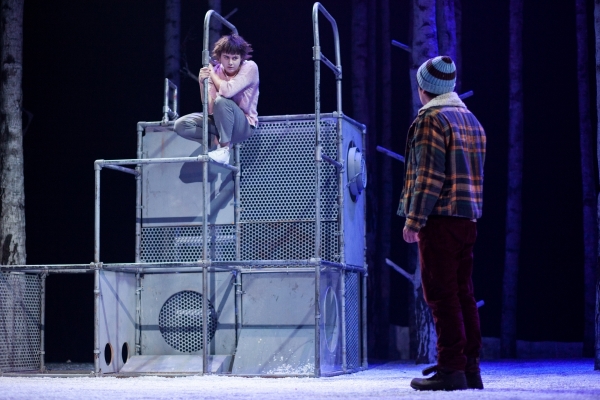
Dripping from the Swedish page and screen onto American stages, The National Theatre of Scotland has adapted the celebrated horror film and novel Let The Right One In for theatrical production with an eerie success that echoes the story's previous manifestations. Wrapping up its run at Seattle's Moore Theatre before moving on to Houston, Texas, this production is spreading its paradoxically beautiful and yet starkly nihilistic brand of love story.
Though not uncommon in recent years, adapting from film to the stage seems like a backwards proposition, particularly when a stage production lamely tries to merely relive the film version preceeding it, milking its signature moments for an audience nodding at what they already know. However, this production defies those pitfalls, succeeding in making its own explorations of expression while maintaining the essential themes and uniquely bleak qualities.
Leading this unlikely adaptive victory is director John Tiffany. Tiffany's keen vision embraces theatricallity, showcasing Christine Jones's snow-driven and haunting wooded set design, bringing furniture out into the elements to play out interior scenes, bravely fostering the audience's suspension of disblief instead of weighing the piece down with more literal locations. While this is often a more mechanical aspect of modern theatre, Tiffany digs into more traditional roots of weaving set changes into the thread of the story, even making the occasional comic wink at the pragmatics of their actions. The continous flow of the piece is also aided and enhanced by the efforts of Movement Director, Steven Hoggett. Utilizing modern dance, the cast button-hooks scenes and emotional transitions through choreographed movement executed with a not-quite-syncroated uniformity, offering a beautifully personal emotive quality from each individual actor.
Navigating a script which is relatively sparse with the content of its dialgoue, the cast manages to provide depth between the lines through their deeply rooted inflections and expressions. Lucy Mangan, in the uncanny leading female role of "Eli", captures a being trapped in a brand of limbo more ambigious than most traditional depictions of this horror archetype. Mangan's reactions possess the quirky honesty of a child while, at the same time, belying the wisdom of a darker truth tied to her more eternal experience. Cristian Ortega offers an innocent contrast as "Oskar", the young boy faced with the deceptively opptomistic option of "letting Eli in", deepening the tragic elements of the story with his emotive face and honest protrayal of this flawed and complicated kid who is more sinned against than sinning. Ewan Stewart's "Hakan" takes a diversion from previously depicted pedophile of the novel and film, instead seeing him as an earlier version of Oskar and tragically implying the fate that waits for anyone who embraces Eli. Shadowing any genuine feelings that may inspire their initial union is the more primitive power of time which promises to consume any love with its insatiable hunger. Stephen McCole gives a stand-out perfomance as "Mr. Avila", a traditional coach character who displays an unstereotypicaj sensitivity to Oskar's needs while maintaining a more traditional interpriation of masculinity.
There is an overall ominious nature to this production, which is properly in keeping with the versions proceeding it, and deeply enhaced by a powerful use of lights and sound. Olafur Arnalds's original music pulses like an underlying heartbeat which rises to intimating volumes and intensities in moments which organically inspire such elevations as masterfully conducted by Gareth Fry's sound design. This is complimented by Chahine Yavroyan's lighting design which properly matches the seething tensions punctuated with sudden and violent peaks.
There are some aspects of this story that lend themselves better to film, partially due to the visually inclined elements of horror, but the play does work well to expose the story's undeniably desolate take on love. No matter how deeply felt and fervently desired, Eli's love is fettered by a kind of curse which will eventually destory those who are compelled to take her hand as a partner. While there is a breath of beauty in this doomed darkness, it is also ultimately weighed down by a slow-choking inevitability. These themes and motifs are heavy, unyielding, and aptly captured in this strange and touching stage version.
